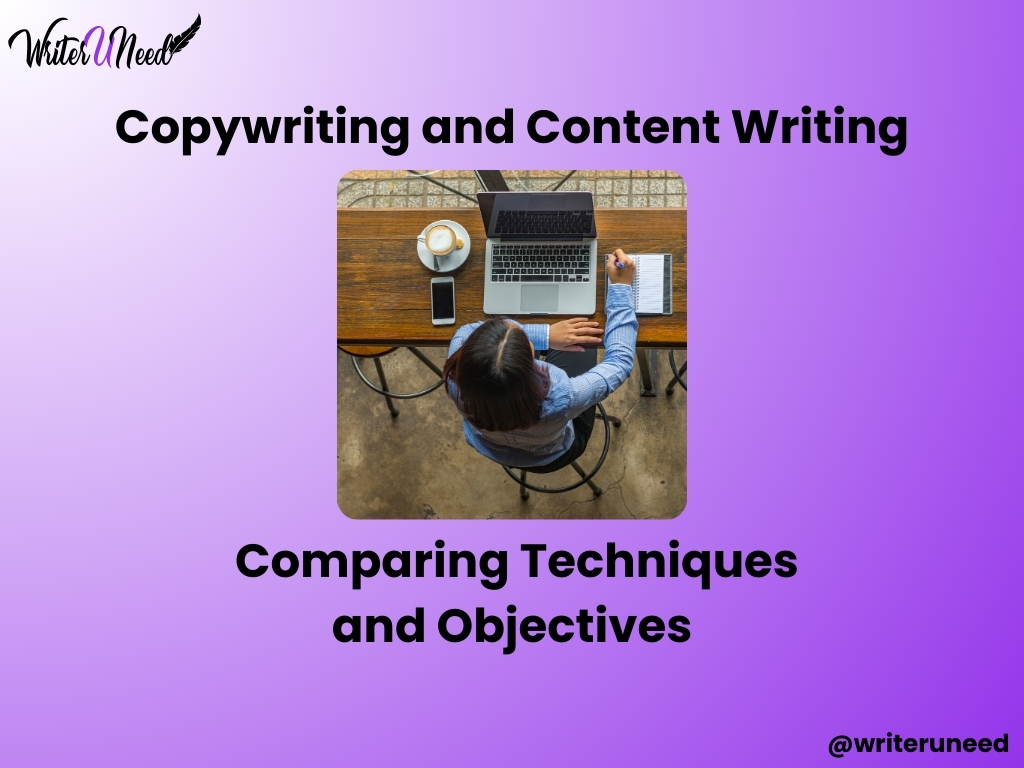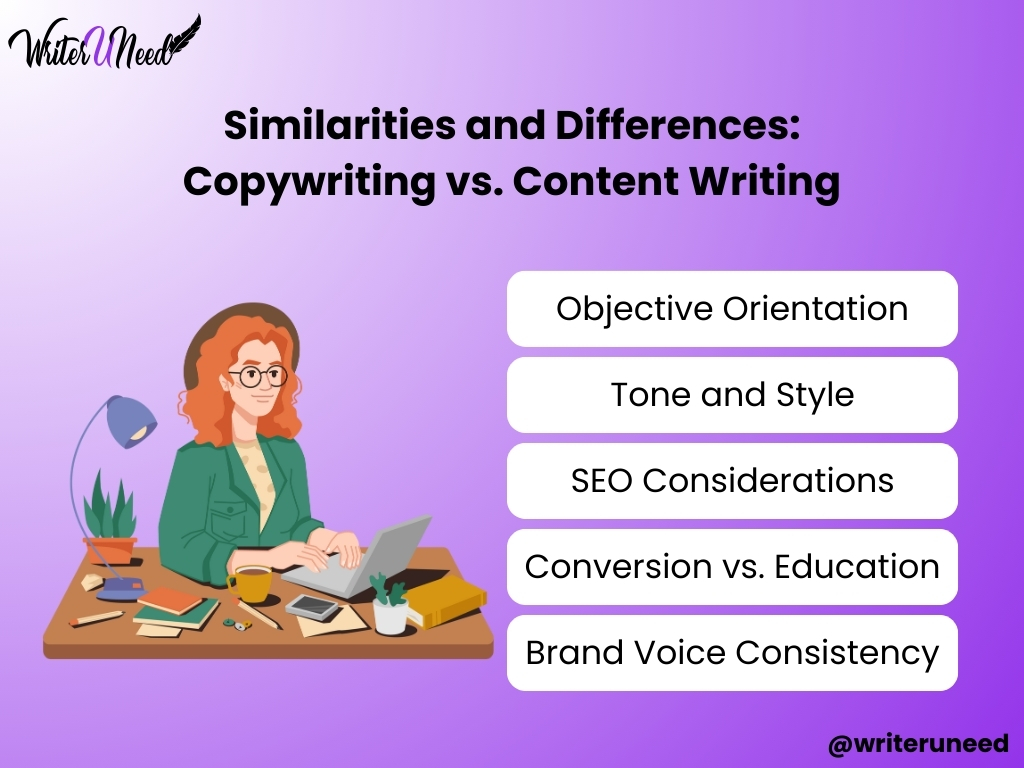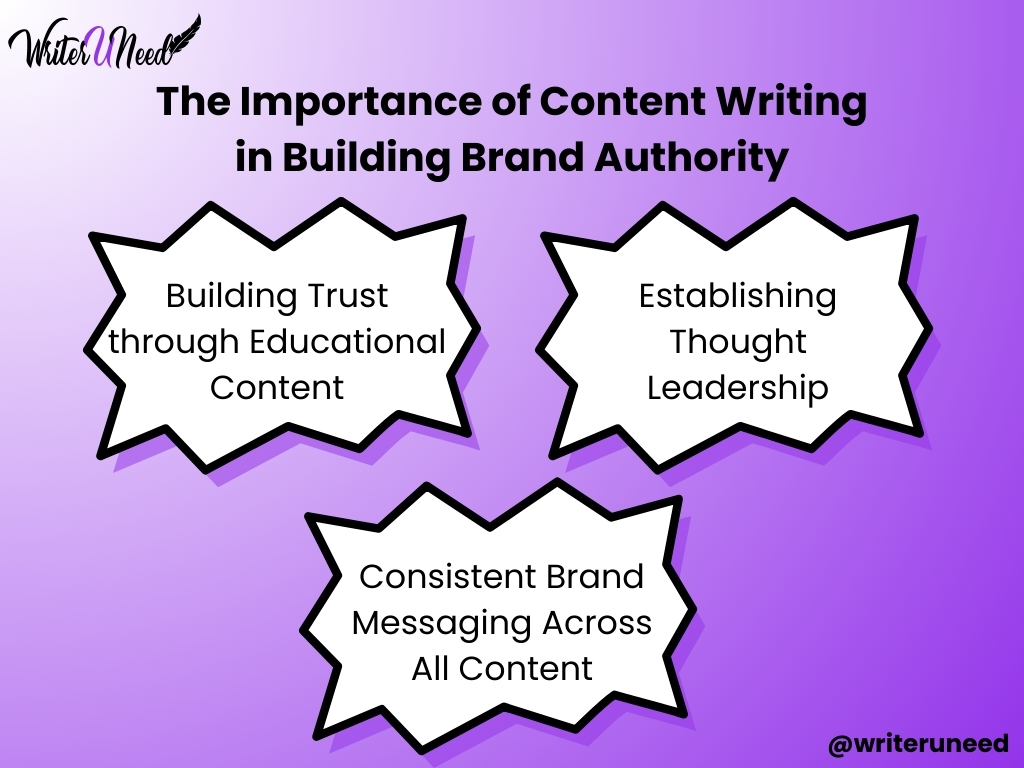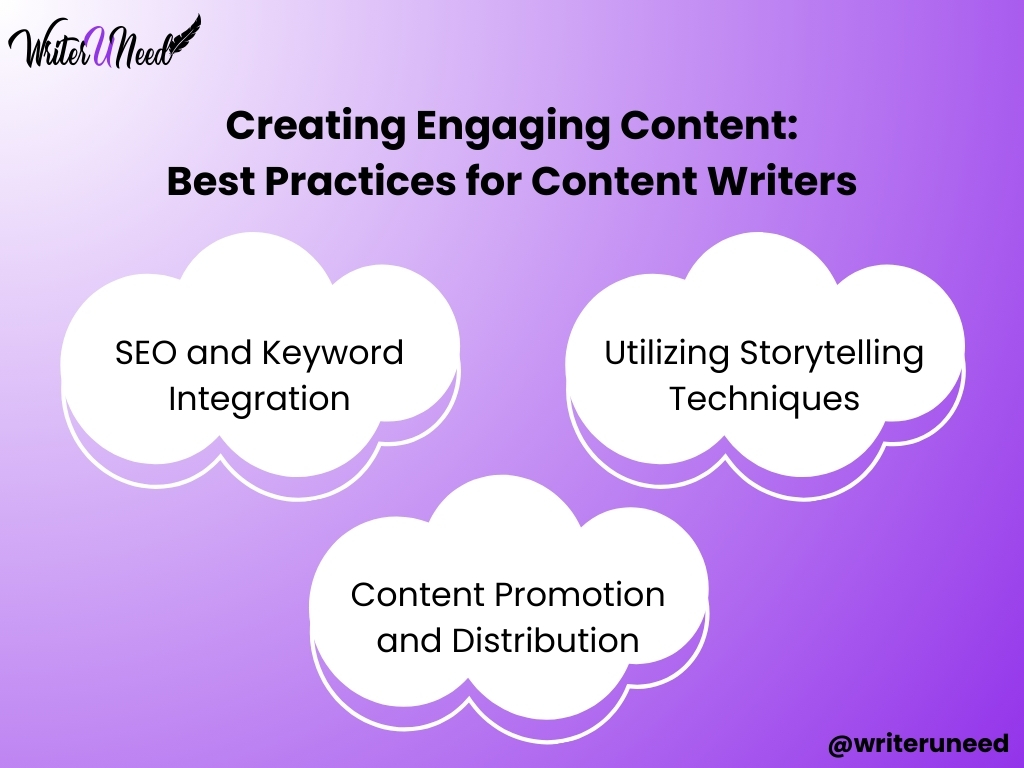
Are you ready to elevate your brand's voice and drive meaningful engagement with your audience?
Our expert team is here to guide you through the intricacies of both disciplines, ensuring your message resonates deeply with your target audience, whether you aim to boost conversions, establish brand authority, or both.
Copywriting and content writing are two distinct strategies used in marketing, each serving different purposes. Copywriting is aimed at crafting persuasive messages to encourage sales and actions, utilizing emotional appeals and storytelling. Its primary goal is persuasion. Content writing, conversely, focuses on providing informative and valuable content to educate and engage the audience, thereby building brand trust and authority. This involves thorough research and presentation of relevant information.
While both require strong writing skills and creativity, copywriting is centered on driving sales, and content writing on education and engagement. Effective marketing strategies often blend both approaches to not only drive conversions but also inform and build credibility with the audience. Businesses should select the method that aligns with their marketing objectives, balancing the need to drive sales with building brand authority.
Table of Contents
- Introduction: Understanding the Difference Between Copywriting and Content Writing
- Defining Copywriting: Techniques and Objectives
- Exploring Content Writing: Techniques and Objectives
- Similarities and Differences: Copywriting vs. Content Writing
- The Role of Copywriting in Marketing and Advertising
- The Importance of Content Writing in Building Brand Authority
- Crafting Persuasive Copy: Strategies and Tips for Copywriters
- Creating Engaging Content: Best Practices for Content Writers
- Maximizing Results: Combining Copywriting and Content Writing Techniques
- Final Thoughts: Choosing the Right Approach for Your Business
Introduction: Understanding the Difference Between Copywriting and Content Writing
In the world of marketing and advertising, two terms that often come up are copywriting and content writing. Although they may sound similar, they encompass distinct techniques and objectives. Copywriting is aimed at creating persuasive and compelling content to drive sales and conversions, while content writing is designed to provide valuable and informative content to engage and educate the audience. Understanding the differences between these two approaches is crucial for businesses to effectively communicate their message and achieve their marketing goals.
Defining Copywriting: Techniques and Objectives

Copywriting is the art of crafting persuasive messages that motivate the audience to take action. It involves using persuasive language, emotional appeals, and storytelling techniques to instill a sense of urgency and desire in the reader. The primary goal of copywriting is to drive sales, generate leads, and increase conversions. Copywriters often collaborate with marketing teams to create advertisements, sales letters, landing pages, and other promotional materials.
- Understanding the Target Audience: The foundation of effective copywriting is a deep understanding of the target audience. This involves researching their needs, desires, pain points, and behavior. Techniques like creating buyer personas and conducting A/B testing can help refine messages to resonate more effectively with the intended demographic.
- Emotional Triggers and Persuasion: Copywriting is not just about informing—it’s about persuading. Techniques such as storytelling, using power words, and tapping into the psychological triggers like scarcity (urgency), social proof, and authority can significantly enhance the persuasive power of the copy.
- Clarity and Conciseness: In the digital age, attention spans are short. Effective copywriting must convey the message clearly and quickly. This means using simple language, short sentences, and bullet points to enhance readability and retain the reader’s attention.
- SEO and Copywriting Fusion: With the omnipresence of digital platforms, integrating SEO best practices with copywriting is crucial. This involves keyword research, optimizing meta tags, and structuring content for readability and engagement, ensuring that the copy not only persuades but also ranks well in search engine results.
- The AIDA Model: Understanding and implementing the AIDA model (Attention, Interest, Desire, Action) can guide the structure of persuasive copy. Each piece of content should first grab attention, generate interest, create desire, and finally prompt an action, whether it's making a purchase, signing up for a newsletter, or following a social media account.
- Multichannel Copywriting Strategy: Copywriting is not confined to just one platform. Effective copywriting strategies span across websites, email campaigns, social media, and more. Understanding the nuances and expectations of each platform can help in crafting tailored messages that engage audiences across different touchpoints.
- Testing and Optimization: Continuous testing is key to refining copywriting efforts. Techniques like A/B testing or multivariate testing on headlines, call-to-actions (CTAs), and email subject lines can reveal insights into what resonates best with the audience, leading to higher conversion rates.
- Value Proposition and Differentiation: Effective copywriting clearly communicates the unique value proposition of the product or service, distinguishing it from competitors. This involves highlighting unique features, benefits, and reasons why the audience should choose one brand over another.
- Visual Elements in Copywriting: Incorporating visual elements like images, videos, and infographics with copy can enhance message delivery and engagement. Visuals can break up text, illustrate points, and create a more engaging and memorable experience for the reader.
- Ethical Copywriting and Transparency: With growing concerns about privacy and misleading information, ethical copywriting has never been more important. This means avoiding exaggerated claims, respecting privacy, and being transparent about the product or service being sold. Building trust with the audience through honest communication can lead to longer-lasting customer relationships.
In summary, modern copywriting is a complex discipline that requires a blend of creativity, psychological insight, strategic thinking, and technical savvy. By staying informed about these techniques and objectives, copywriters can craft compelling messages that not only engage and persuade but also build lasting connections with their audience.
Exploring Content Writing: Techniques and Objectives
Conversely, content writing focuses on creating valuable and informative content that engages and educates the audience. It involves researching, organizing, and presenting information in a manner that is easy to understand and relevant to the target audience. The primary objective of content writing is to build brand authority, establish trust, and provide value to the readers. Content writers frequently produce blog posts, articles, social media posts, and other forms of content aimed at informing, entertaining, or inspiring the audience.
- Audience-Centric Writing: Develop a deep understanding of your target audience. This involves creating detailed audience personas to identify their interests, challenges, and needs. Content should be tailored to address these specifics, ensuring it resonates and provides value to the readers. Techniques include using audience-specific language, addressing their pain points, and offering actionable solutions.
- SEO Optimization: Incorporate SEO strategies into content writing to enhance visibility on search engines. This involves keyword research, using relevant keywords naturally within the text, optimizing meta tags, and creating engaging, high-quality content that encourages backlinks. Understanding the latest SEO trends and algorithm updates is crucial for staying ahead in the digital space.
- Storytelling Techniques: .Employ storytelling to make content more engaging and memorable. This involves crafting narratives that connect with readers on an emotional level, using real-life examples, anecdotes, or case studies. Storytelling can help in making complex information more accessible and in building a stronger brand connection with the audience.
- Data-Driven Content: Utilize data and analytics to inform content creation. This means analyzing performance metrics of existing content to understand what works best and using this data to guide future content strategies. Incorporating data, statistics, and research findings within the content also adds credibility and value for the readers.
- Multimedia Integration: Enhance written content with multimedia elements such as images, videos, infographics, and interactive media. This not only makes the content more engaging and shareable but also caters to different learning styles and preferences among the audience. Techniques include using relevant and high-quality visuals and ensuring they are optimized for web.
- Content Repurposing: Maximize the value of content by repurposing it across different formats and platforms. A long-form blog post, for example, can be broken down into social media posts, an infographic, or even a short video. This approach helps in reaching a wider audience and reinforces the message through repetition in various formats.
- Consistent and Strategic Content Planning: Develop a content calendar that aligns with marketing goals, seasonal trends, and audience interests. Consistency in publishing helps in building an engaged audience and establishing brand authority. Planning involves identifying key topics, scheduling posts, and allocating resources for content creation and promotion.
- Interactive Content Creation: Create interactive content such as quizzes, polls, or interactive infographics to increase engagement and provide personalized value to the audience. This type of content encourages active participation, making the experience more memorable and likely to generate leads or conversions.
- Thought Leadership Content: Establish brand authority by producing thought leadership articles that offer unique insights, innovative ideas, or expert opinions on industry trends. This involves identifying thought leaders within the organization, leveraging their expertise, and presenting content that challenges the status quo or offers new perspectives.
- User-Generated Content Encouragement: Encourage and leverage user-generated content (UGC) as part of the content strategy. This could involve creating campaigns that invite user participation, featuring customer stories, or curating user reviews and testimonials. UGC not only provides authentic content but also fosters a sense of community and engagement among the audience.
Exploring these content writing techniques and objectives can significantly enhance the effectiveness of content marketing efforts, helping to build a loyal audience, establish brand authority, and achieve business goals.
Similarities and Differences: Copywriting vs. Content Writing

While copywriting and content writing serve different objectives, they also share some similarities. Both require strong writing skills, creativity, and an understanding of the target audience. They aim to engage the reader and communicate a message effectively. However, the key difference lies in their techniques and objectives: copywriting focuses more on persuasion and sales, whereas content writing emphasizes providing valuable information and building brand authority.
- Objective Orientation: Both copywriting and content writing aim to elevate a brand's communication with its target audience. However, copywriting is primarily driven by the goal of converting readers into customers, focusing on immediate action (e.g., making a purchase, signing up for a newsletter). Content writing, on the other hand, seeks to inform, educate, and entertain, thereby nurturing a long-term relationship between the brand and its audience.
- Tone and Style: Copywriting often adopts a persuasive, direct tone designed to compel action. It's crisp, to the point, and laden with calls-to-action (CTAs). Content writing, conversely, tends to embrace a more conversational or informative tone, aiming to engage the reader through valuable insights and storytelling.
- SEO Considerations: While both domains recognize the importance of SEO, content writing places a heavier emphasis on integrating keywords seamlessly into articles, blog posts, or guides to improve search engine rankings and visibility. Copywriting does incorporate SEO but is more focused on the persuasive strength of the words than on keyword density.
- Format and Structure: Copywriting is often seen in shorter formats such as ad copy, product descriptions, and landing pages. Content writing spans a broader range of formats, including blog posts, articles, white papers, and eBooks, which allow for deeper exploration of topics.
- Audience Engagement: Both strive to engage the audience, but through different means. Copywriting engages by creating a sense of urgency and tapping into the reader's emotions and desires. Content writing engages by providing useful information, answering questions, and positioning the brand as a thought leader in its industry.
- Research Depth: Content writing typically requires more in-depth research to produce informative, accurate, and valuable content. Copywriting also involves research, especially about the product and the audience's pain points, but it is usually more focused on crafting compelling messages than on in-depth topic exploration.
- Conversion vs. Education: This is a pivotal difference. Copywriting is conversion-oriented, directly aiming to influence buying behavior. Content writing, while it can indirectly support conversions by building trust and authority, is more educationally oriented.
- Brand Voice Consistency: Both require a deep understanding of the brand's voice and the ability to consistently convey it across all written materials. This consistency helps in building a recognizable and reliable brand identity.
- Analytical Skills: Copywriters and content writers must possess analytical skills, but the focus may differ. Copywriters analyze customer behavior and conversion metrics to refine their strategies. Content writers, though, might analyze engagement metrics (like time on page, bounce rates) to understand what content resonates best with their audience.
- Creative Collaboration: In both fields, collaboration with other creative professionals (designers, SEO specialists, marketers) is crucial to ensure that the written content aligns with the overall marketing strategy and enhances the user experience.
Understanding these nuances is key for businesses to effectively leverage copywriting and content writing in their marketing strategies. While they employ distinct approaches, both are integral to creating a comprehensive, engaging, and persuasive brand narrative that resonates with the target audience.
The Role of Copywriting in Marketing and Advertising
Copywriting plays a crucial role in marketing and advertising. It is the driving force behind successful sales campaigns and persuasive advertisements. Effective copywriting captures the audience's attention, creates a desire for a product or service, and ultimately leads to conversions. Copywriters employ various techniques such as crafting compelling headlines, using emotional appeals, and incorporating persuasive language to engage the reader and encourage action.
- Narrative Storytelling: The power of storytelling in copywriting cannot be overstated. By weaving a compelling narrative around a product or service, brands can create a relatable and memorable experience for the audience. This approach taps into the emotional aspect of decision-making, making it more likely for the audience to engage and convert.
- SEO-Driven Copywriting: In the digital age, the role of SEO (Search Engine Optimization) in copywriting is paramount. Crafting content that not only appeals to the target audience but also ranks well on search engines can significantly increase visibility and drive organic traffic. By incorporating keywords strategically without compromising the quality of content, copywriters can achieve a balance between readability and searchability.
- A/B Testing for Copy: The use of A/B testing allows marketers to understand which copy elements resonate most with their audience. By testing different headlines, call-to-actions (CTAs), and content structures, copywriters can refine their approach based on concrete data, leading to higher conversion rates and more effective campaigns.
- Personalization and Customization: With the advent of big data and advanced analytics, copywriters can now tailor their messages to specific segments of their audience. Personalized copy that addresses the unique needs, desires, and challenges of an audience segment can significantly increase engagement and conversions.
- Incorporating User-Generated Content: Leveraging user-generated content (testimonials, reviews, and social media posts) in copywriting adds authenticity and trustworthiness to the brand’s message. This approach not only engages the community but also provides real-life proof of the value of a product or service.
- Multichannel Copywriting Strategy: Effective copywriting today requires a comprehensive approach that spans across multiple platforms and channels - from traditional print ads to social media, email marketing, and websites. Each channel requires a nuanced approach to copy that aligns with its unique format and audience expectations, ensuring a cohesive brand message.
- Interactive and Engaging Content: Creating interactive content like quizzes, polls, and interactive infographics can boost engagement significantly. Copywriters play a crucial role in crafting the questions and responses in these formats, making the content not only informative but also enjoyable for the audience.
- Ethical and Transparent Copywriting: With increasing awareness about misleading advertising, there is a strong need for ethical copywriting that is honest and transparent. Copywriters must ensure that the claims made in their copy are substantiated, avoiding exaggerated benefits or misleading information.
- Emotional Intelligence in Copywriting: Understanding and leveraging emotional intelligence to craft copy that speaks directly to the audience’s emotions, fears, and aspirations can dramatically increase its effectiveness. This involves a deep understanding of the psychological triggers that motivate people to act.
- Continuous Learning and Adaptation: The digital landscape is constantly evolving, and so are the techniques and strategies in copywriting. Staying informed about the latest trends, understanding new platforms, and adapting copy to meet the changing preferences of the audience are essential skills for copywriters in the current marketing ecosystem.
By focusing on these aspects, copywriters can significantly enhance their contribution to marketing and advertising campaigns, driving better results for brands and creating more meaningful connections with the audience.
The Importance of Content Writing in Building Brand Authority

Content writing is equally important for building brand authority and establishing trust with the audience. By providing valuable and informative content, businesses can position themselves as industry experts and thought leaders. High-quality content can attract and engage the target audience, increase website traffic, and improve search engine rankings. Content writers focus on creating content that is relevant, well-researched, and tailored to the needs and interests of the target audience.
- Establishing Thought Leadership: Content writing is a pivotal tool for businesses to establish themselves as thought leaders within their industry. By consistently publishing insightful, original content on industry trends, challenges, and innovations, companies can distinguish themselves from competitors and build a reputation as authoritative sources of information.
- Enhancing SEO: Quality content writing is integral to Search Engine Optimization (SEO). By incorporating targeted keywords, addressing user queries, and producing in-depth content, businesses can improve their search engine rankings. This not only increases visibility but also positions the brand as an authority, as search engines tend to favor content that provides value to users.
- Building Trust through Educational Content: Providing educational content that helps solve problems or answer questions can significantly build trust with the audience. When a brand consistently offers valuable information without overtly selling, it fosters a relationship built on trust, positioning the brand as a reliable resource.
- Leveraging Content to Showcase Expertise: Content writing allows businesses to showcase their expertise and knowledge in their field. Whether it’s through detailed blog posts, white papers, or case studies, demonstrating an in-depth understanding of the industry and its challenges can reinforce a brand’s authority.
- Engaging with the Community through Content: Interactive content such as Q&As, webinars, and forums can engage the audience and foster a community around the brand. This not only enhances brand loyalty but also further establishes the brand's authority by directly addressing and interacting with the audience.
- Utilizing User-generated Content to Boost Credibility: Encouraging and sharing user-generated content, such as customer reviews, testimonials, and case studies, can significantly enhance a brand's credibility. Seeing real-life applications and endorsements of a brand's products or services can strengthen its authority in the field.
- Content Collaboration with Industry Experts: Collaborating with other experts or influencers in the industry for content creation can lend additional credibility and authority to a brand. Guest posts, expert interviews, and co-authored research papers are excellent ways to leverage external expertise and networks.
- Consistent Brand Messaging Across All Content: Ensuring that all content produced aligns with the brand’s core messages, values, and tone of voice is crucial in building brand authority. Consistency helps in reinforcing the brand’s identity and positions it as a dependable source in the industry.
- Adapting to Emerging Trends and Technologies: Staying ahead of industry trends and incorporating the latest technologies in content creation (like AI, VR, or interactive content) can set a brand apart as an innovative leader. It demonstrates a commitment to providing cutting-edge information and solutions to the audience.
- Measuring and Analyzing Content Performance: Regularly analyzing content performance metrics allows brands to understand what resonates with their audience. Using this data to refine and tailor future content ensures that the brand remains relevant and authoritative by consistently meeting the audience's needs and interests.
Implementing these strategies requires a commitment to quality, consistency, and a deep understanding of the target audience. By prioritizing content writing, businesses can significantly enhance their brand authority and foster a loyal customer base.
Crafting Persuasive Copy: Strategies and Tips for Copywriters
To craft persuasive copy, copywriters use various strategies and techniques. Understanding the target audience and their pain points allows copywriters to create a connection and resonate with readers. Employing storytelling techniques to engage the audience emotionally and using strong, persuasive language are effective methods. Additionally, incorporating social proof and creating a sense of urgency can enhance the persuasiveness of the copy.
- Understand Your Audience Deeply: Start by developing a comprehensive understanding of your target audience. This includes demographic details, psychographic profiles, motivations, fears, and desires. Use this information to tailor your message in a way that speaks directly to them, making your copy more relatable and persuasive.
- Leverage Storytelling: Humans are naturally drawn to stories. Incorporate storytelling in your copy to create an emotional connection with your audience. A well-crafted narrative can make your message more memorable and engaging, leading to higher conversion rates.
- Use Persuasive Language: Words are powerful tools that can evoke emotions and drive action. Use strong, action-oriented language that encourages readers to take the next step. Words like "discover," "achieve," and "transform" can be more motivating than their passive counterparts.
- Employ Social Proof: Social proof, such as testimonials, reviews, and case studies, can significantly enhance your copy's persuasiveness. Seeing that others have benefited from a product or service reduces perceived risk and builds trust with your audience.
- Create a Sense of Urgency: Encouraging prompt action is key in persuasive copy. Phrases like "limited time offer," "exclusive access," or "while supplies last" can create a sense of urgency that compels readers to act immediately.
- Focus on Benefits, Not Features: Instead of listing the features of a product or service, focus on how it benefits the user. People are more interested in what a product can do for them than in its specifications. Highlighting benefits addresses the audience's pain points and demonstrates how their lives will improve.
- Use Psychological Triggers: Understanding and leveraging psychological triggers can significantly enhance your copy's effectiveness. Triggers such as authority, reciprocity, and scarcity can subtly influence readers' decision-making processes.
- Optimize for Clarity and Readability: Your copy should be easy to read and understand. Use short sentences, bullet points, and subheadings to break up text and make your points clear. Avoid jargon and technical language that might alienate or confuse your audience.
- Test and Refine: The best copywriters continuously test different versions of their copy to see what resonates most with their audience. Use A/B testing to experiment with different headlines, calls to action, and layouts to optimize your copy for conversions.
- Keep Learning and Adapting: The digital landscape and consumer behavior are always evolving. Stay updated with the latest copywriting trends, techniques, and tools. Don't be afraid to experiment with new approaches or to adapt your strategies based on feedback and results.
By incorporating these strategies and continuously refining your approach based on results and feedback, you can significantly improve the persuasiveness of your copywriting and achieve better outcomes for your campaigns.
Creating Engaging Content: Best Practices for Content Writers

Content writers also follow best practices to create engaging content. Conducting thorough research ensures the accuracy and relevance of the content, thereby establishing credibility and building trust with the audience. Writing in a conversational and engaging tone, using storytelling techniques, incorporating visuals, and breaking content into digestible chunks keep readers engaged and interested. Optimizing content for search engines and promoting it through various channels are also essential practices for content writers.
- Audience Research and Persona Development: Before typing the first word, understand who your audience is. Conduct detailed audience research and develop buyer personas. Knowing your audience's challenges, interests, and language helps tailor your content to resonate with them more effectively.
- Headline Crafting Mastery: The headline is the first impression of your content. Spend time crafting headlines that grab attention, evoke curiosity, and promise value. Utilizing formulas and emotional triggers can significantly increase your content's click-through rate.
- SEO and Keyword Integration: While writing engaging content is crucial, making sure it's found is equally important. Perform keyword research to understand what your audience is searching for. Integrate these keywords naturally into your content, including titles, headings, and throughout the body, to optimize for search engines without compromising readability.
- Utilizing Storytelling Techniques: Stories captivate us. Incorporate storytelling into your content to make it more relatable and memorable. Use real-life examples, case studies, and narratives to illustrate points and engage readers on a deeper level.
- Incorporating Visuals and Multimedia: Visuals can significantly enhance the appeal and comprehensibility of your content. Use relevant images, infographics, videos, and interactive elements to break up text, illustrate points, and improve user engagement.
- Actionable and Practical Information: Ensure your content provides value by including actionable tips, strategies, and practical advice. Empower your readers with the knowledge they can apply directly, increasing the utility and shareability of your content.
- Formatting for Readability: Large blocks of text can intimidate readers. Use short paragraphs, bullet points, and subheadings to break up your content into digestible chunks. This improves readability and makes it easier for readers to scan for information.
- Engaging and Conversational Tone: Write as if you're having a conversation with your reader. A friendly, engaging tone can make your content more relatable and enjoyable to read. Use questions, direct address, and a casual style to foster a connection with your audience.
- Feedback and Revision Process: Great content is often the product of revision. Seek feedback from peers, editors, or your target audience to identify areas for improvement. Be open to criticism and willing to revise your content to enhance its clarity, persuasiveness, and engagement.
- Content Promotion and Distribution: Creating great content is just the beginning. Develop a content promotion strategy to get your content in front of your target audience. Utilize social media, email marketing, influencer partnerships, and other channels to increase your content's reach and impact.
By adopting these best practices, content writers can create more engaging, valuable, and effective content that stands out in a crowded digital landscape.
Maximizing Results: Combining Copywriting and Content Writing Techniques
Although copywriting and content writing have distinct techniques and objectives, combining them can lead to powerful results. Incorporating persuasive copywriting techniques into content writing can create engaging and informative content that also drives conversions. For example, using persuasive language and calls to action in blog posts or incorporating storytelling techniques in product descriptions can make the content more compelling. By leveraging the strengths of both approaches, businesses can maximize their marketing efforts and achieve their goals more effectively.
- Strategic Storytelling in Educational Content: Use copywriting's storytelling ability to weave compelling narratives around educational content. This makes the information more relatable and memorable, encouraging deeper engagement from the audience.
- Persuasive Case Studies: Turn traditional case studies into persuasive stories. Start with the problem (hook), narrate the journey (build-up), and conclude with the solution your product or service provided (call to action). This approach not only informs but also persuades the reader of the value you offer.
- Benefit-Driven Headlines in Informative Articles: Craft your article headlines with a copywriting lens—focus on the benefit to the reader. An informative piece with a headline that promises a clear benefit will attract more readers and keep them engaged.
- SEO-Driven Yet Persuasive Product Descriptions: Merge SEO content writing techniques with persuasive copywriting for product descriptions. Use targeted keywords naturally while focusing on the benefits of the product and evoking emotions that drive purchases.
- Interactive Content with Persuasive Triggers: Create quizzes, polls, or interactive infographics that educate but also guide the user towards a call-to-action. Use persuasive language to make participation irresistible.
- Email Newsletters That Tell a Story: Use content writing to provide value and educate your subscribers, but weave in copywriting techniques to tell a story that leads to a product or service plug naturally and compellingly.
- Blogging with a Purpose: Every blog post should have a clear purpose beyond just informing. Whether it’s to sign up for a newsletter, download an eBook, or consider a product, use persuasive calls to action that fit seamlessly within valuable content.
- Social Proof with Authenticity: When integrating customer testimonials or reviews into your content, use authentic storytelling techniques to present them. This approach enhances credibility and engages the reader more effectively than presenting raw data or statements.
- Using Psychological Triggers in Content Layouts: Layout your content to lead the reader through a journey—use headlines, images, and body text with psychological triggers that guide the reader towards your desired action, without them feeling coerced.
- Content Series with a Conversion Goal: Plan a series of content pieces (blogs, videos, podcasts) that educate and engage the audience on a topic, with each piece subtly guiding them closer to a conversion goal. This series can use storytelling to keep the audience coming back for more, building trust and interest that culminates in a persuasive call to action.
Combining copywriting and content writing is not just about being more persuasive; it's about creating a richer, more engaging experience for your audience that not only informs but also inspires action. By carefully balancing informational depth with persuasive elements, businesses can craft content that resonates more deeply with their audience and drives tangible results.
Final Thoughts: Choosing the Right Approach for Your Business
When it comes to choosing the right approach for your business, it is important to consider your marketing goals and target audience. If your primary objective is to drive sales and conversions, copywriting may be more suitable. Conversely, if you aim to build brand authority and provide valuable information to your audience, content writing may be the better choice. Often, a combination of both approaches yields the best results. By understanding the differences, techniques, and objectives of copywriting and content writing, businesses can make informed decisions and create compelling and engaging content that resonates with their audience.

Don't miss this opportunity to redefine your marketing strategy and witness tangible results. Contact us now to start transforming your brand's narrative and engaging with your audience like never before.
Let's create something remarkable together.










